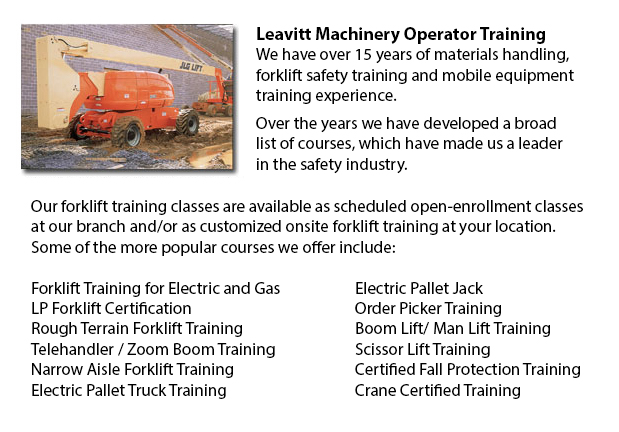
Toronto Boom Lift Operator Training - A cherry picker is a kind of aerial work platform. Cherry pickers consist of a platform or bucket at the hydraulic lifting system's end. The device is also called a man lift, boom lift, hydraladder or basket crane.
The bucket of platform is sometimes mounted to or set unto a truck or other vehicle and is sometimes referred to as a bucket truck. Other vehicles which can be utilized are stand-alone trailers, self-moving platform or flat back pickup vans. The worker stands inside the bucket and works from there. The person in the bucket usually comprises an upper set of controls enabling control of the bucket's position. The reach of the bucket could be extended on some models by telescoping to adjust the lifting arm. Automatic safety controls prevent tipping. Articulated boom lifts are recommended for working in tight areas or when it is required to clear obstacles.
As the name suggests, cherry pickers were made for picking fruit in trees at high levels. Cherry pickers are used in various other businesses, such as mining, exterior painting and construction. Sometimes they are made use of for cleaning windows on high rise. The devices are utilized to service telephone, cable television and electrical equipment on utility poles. Occasionally, firefighters use cherry pickers, know as snorkels, when ladders are insufficient. During Christmas season, civic workers can be seen hanging banners and lights within cherry pickers.
Boom Lift Operator Safety Training
The business recommends Safety Awareness Training meets standards set by your local regulations. Curriculum consists of safe operation procedures through a combination of hands-on and classroom components.
Sessions comprise the following topics: general equipment safety matter; current regulations and applicable concerns; features of boom lifts; fall protection, various stationary work platform and scissor lifts.
The lift operator's responsibilities are covered, like the following topics: function test procedure; workplace inspections; knowing and avoiding hazards; equipment manufacturer's directions and pre-operation check procedures.
-
Toronto Wheel Loader Training
Toronto Wheel Loader Training - Normally, the different kinds of heavy equipment training are classed into 2 categories of machinery: those that have rubber tires and tracked vehicles. Tracked vehicles consist of items like for example excavators, cr... More -
Toronto Heavy Equipment Operator Training
Toronto Heavy Equipment Operator Training - Heavy equipment operator training facilities that provide good standards in the business, providing field performance tasks and added machinery training are really sought after training features. Students a... More -
Toronto Manlift Operator Certification
Toronto Manlift Operator Certification - We provide an aerial lift and scissor platform certification and training to empower the trainee with the general understanding and knowledge of the safe and efficient use of "Power Operated Mobile Work Platfo... More -
Toronto Aerial Boom Lift Ticket
Toronto Aerial Boom Lift Ticket - Aerial lifts can be utilized to accomplish a lot of unique duties done in hard to reach aerial spaces. Some of the odd jobs associated with this type of jack include performing regular preservation on structures with... More -
Toronto Heavy Equipment License
Toronto Heavy Equipment License - Obtaining a heavy equipment license is mandatory in order to operate these big industrial machinery. Certification could be acquired through a vocational school or private training. The license would enable the drive... More -
Skid Steer Loader Training in Toronto
A skid-steer loader is an engine powered equipment which consists of a small and rigid frame. It is outfitted together with lift arms that are utilized to connect to a large variety of labor saving tools and attachments. Typically, skid-steer loaders... More -
Toronto Aerial Lift Certification
Toronto Aerial Lift Certification - Aerial Lift Certification is for individuals who requires an in-depth understanding of aerial lift safety. Inspectors and operators, supervisors, maintenance workers and construction craftsmen should perform a cert... More -
Toronto Boom Lift Training
Toronto Boom Lift Training - Elevated work platforms, also called aerial platforms, allow workers to carry out tasks at heights which would otherwise be not reachable. There are different kinds of lifts intended for various site conditions and applic... More

Forklift Certification Toronto
TOLL FREE: 1-888-254-6157
Toronto, Ontario
forkliftcertificationtoronto.com
Email Us
About Us


